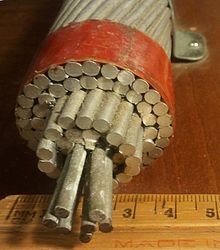
Back Draad Afrikaans Alambre AN سلك Arabic Alambre AST Məftil Azerbaijani Дрот Byelorussian Дрот BE-X-OLD Жица Bulgarian তার Bengali/Bangla Orjal Breton

A wire is a flexible, round, bar of metal. Wires are commonly formed by drawing the metal through a hole in a die or draw plate. Wire gauges come in various standard sizes, as expressed in terms of a gauge number or cross-sectional area.
Wires are used to bear mechanical loads, often in the form of wire rope. In electricity and telecommunications signals, a "wire" can refer to an electrical cable, which can contain a "solid core" of a single wire or separate strands in stranded or braided forms.
Usually cylindrical in geometry, wire can also be made in square, hexagonal, flattened rectangular, or other cross-sections, either for decorative purposes, or for technical purposes such as high-efficiency voice coils in loudspeakers. Edge-wound coil springs, such as the Slinky toy, are made of special flattened wire.[1]
- ^ Swiger Coil Systems. "Edgewound Coils". Swiger Coil Systems, A Wabtec Company. Archived from the original on 19 December 2010. Retrieved 1 January 2011.